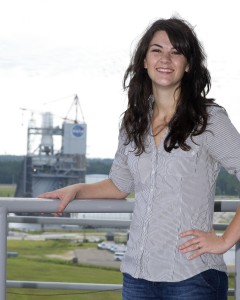As a young girl, Nyla Smith Trumbach dreamed of one day working for NASA’s Space Program and assisting in the agency’s interplanetary travel efforts to Mars and beyond.
The 2004 University of Mississippi alumna’s childhood dream came true when she was hired as a test operations engineer in the space shuttle program at Stennis Space Center.
“I watched NASA’s space shuttle launch from my grandparents’ house in Cocoa Beach, Florida,” Trumbach said. “My grandfather worked at NASA supporting the shuttle program for most of his career. I can remember the windows rattling from the awesome power of the boosters and space shuttle main engines. I never imagined that one day I would work on the SSME test program.”
After high school, Trumbach earned a bachelor’s degree in general engineering with an emphasis in chemistry and biology. As part of the test operations team, she is responsible for preparing the A-1 test stand for hot-fire testing.
“That involves transferring propellants, like liquid hydrogen, to the test stand and conducting RS-25 hot-fire tests,” the Poplarville native said. “Testing rocket engines is so exciting. Watching the engine rumble and roar to life with fire and feeling the ground shake is a very emotional experience. It’s a strange mixture of excitement, anxiousness and fear. I literally cried after our first test in January. Aside from being a stay-at-home parent, this has got to be the best job out there.”
A first-generation college student, Trumbach fondly remembers her favorite Ole Miss engineering professors and courses.
“I really enjoyed the geology/geological engineering courses,” she said. “I love being outdoors, and the geology professors took us on the best field trips. I also loved Dr. (William) Lawhead’s logic class.”
UM engineering faculty remember Trumbach as a brilliant student.
“Nyla was someone who didn’t draw attention to herself, yet always managed to stand out from her peers in whatever she did,” said Marni Kendricks, assistant engineering dean for undergraduate academics. “Her achievements before and since graduation are nothing short of amazing. I think she makes a wonderful representative for both the general engineering program and women in engineering.”
Being a part of the RS-25 test team is a great opportunity and privilege, Trumbach said. “We’re working on America’s next great rocket. I can’t wait to see what the future holds for SLS.”
Working at NASA has been a great experience, but Trumbach readily admits that it can be challenging at times.
“I had many fears along the way, but each time I faced an obstacle head-on, I grew stronger,” she said. “You won’t always succeed. Sometimes you will fail. However, I have found that you typically profit more from the failures than you do the successes.”
Trumbach attributed her career success to the close family ties she’s maintained and continues to build.
“I’ve been blessed with a large, caring family,” she said. “My mother has always been my biggest fan, telling me at a very young age that I could be whatever I wanted to be. She stressed early on that getting an education was a must. Neither of my parents went to college so it was a really big deal for me to go.”
Trumbach’s husband, Jared, is a firefighter in the Gulfport Fire Department. They have two daughters, Phoebe and Greta. She also has two miniature donkeys, five Nigerian dwarf goats and recently started beekeeping as a hobby.
With SLS, NASA is building the capability to put humans back into deep space. Recent achievements are bringing deep-space travel closer than ever. The United States has sent rovers to Mars several times and has left lots of things on the planet’s surface.
A big rocket with next-generation technology is needed to accomplish NASA’s goal of interplanetary human traffic. Many of the pieces are already designed. NASA is halfway through a 17-point check system that began in 2012 and will, hopefully, culminate in a successful launch by 2017.
Trumbach said her Ole Miss engineering education definitely helped launch her successful aerospace career.
“The general engineering degree allowed me to take a variety of courses,” Trumbach said. “One of my primary duties as a test operations engineer at Stennis Space Center is handling cryogenic rocket propellants and various service gases. My studies in chemistry prepared me for understanding and working with liquid hydrogen and liquid oxygen.”
